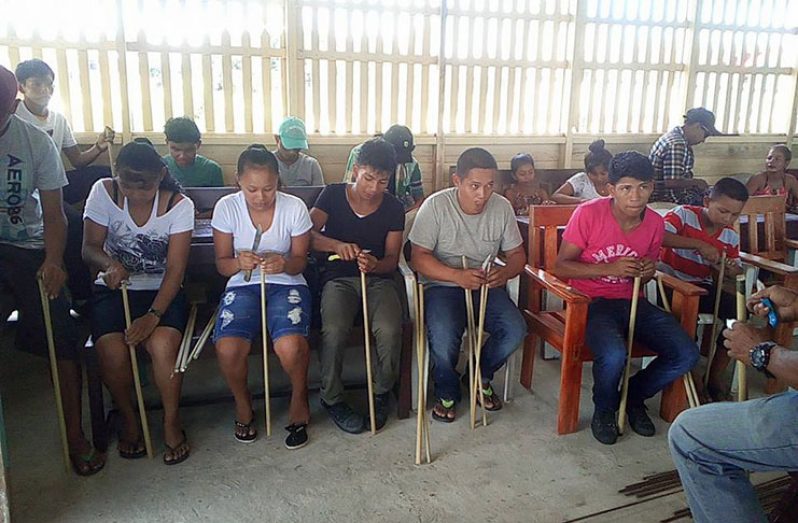– with traditional Handicraft
By Ravena Gildharie
RECOGNISING the need for economic opportunities to keep the youth in their community, the Indigenous village of Wakapoa in the Pomeroon, is currently pursuing a bold initiative to teach handicraft to the younger generation, initially targeting early school leavers’ and dropouts.

Wakapoa reportedly has a current population of 3,000 of which an estimated 40 percent is young people. After school, many are forced to seek employment opportunities outside the village with most of the males heading to the mining districts, and the females relocating to the coastal areas for jobs at private businesses and others places.
Now, through a partnership with the Ministry of Education – Department of Youth and Culture, 20 Indigenous men and women from the community, between the ages of 16 to 25, started a six-week handicraft training on August 28, 2017. The training is being held at the Wakapoa Community Centre and scheduled to last until early October. Participants are being taught handicraft using `Mukru’, a raw material from the forest. Former Toshao, Lloyd Raphael, is the craft teacher and participants are focused on producing traditional items, including egg baskets, matapee, shak-shak, fans and sifters.
The initiative is spearheaded by group leader, Ivan Cornelius, who approached the Region Two, Youth and Culture Officer, Herald Alves, during an outreach to Wakapoa last July. Alves said Cornelius explained the need for a project to teach handicraft to the youth as a form of economic livelihood while helping to preserve Arawak language and culture.
“The idea was to have an initiative beyond just a simple art and craft training. It was intended to teach the youth a traditional skill using mostly traditional raw materials from the community, so that the local customs and practices are passed on, and used to create jobs where the participants could earn an income and remain in their community, instead of going outside to seek jobs as most of them do now,” Alves said.
It is the first community-partnership venture of its kind that the department is engaged with, and already, the focus is on taking the exercise to the next level, seeking to connect interested participants with tertiary skills training at the Essequibo Technical Institute (ETI) and similar foundation, Alves said, At the end of the training, students would be issued certificates of participation and would showcase their products at a mini-exhibition. There are plans to follow up on marketing opportunities and support.

In the meantime, while participants are performing well it is a challenging task, especially for the trainer, since the youths had no previous knowledge about handicraft making. They’ve had to start from basic steps including stripping the Mukru, which is described as “a very technical process that requires specific skills,” , Cornelius disclosed.
With this in mind, he said, six weeks might not be adequate to equip participants and build the level of handicraft skills required to deliver successful economic opportunities. Cornelius observed, too, that if the training should include an incentive, it would attract a greater level of interest and participation.
Currently, he noted, only the elders in the community are skilled in handicraft products, which they market in the Wakapoa community, nearby villages and at the Charity market. However, it is expected that from the ongoing training, a craft group would be established and lucrative market options pursued. One such intention is to market the craft at the neighbouring Adel’s Resort, which accommodates tourists on a year-round basis
Cornelius founded the Arawak Language Craft and Culture Revitalisation Programme in Wakapoa over 12 years ago, to preserve the Indigenous culture and heritage.
He believes it is very important to ensure that the young and upcoming generations not only learn the traditions and practices, but also that they appreciate and recognise the significance of their rich native heritage. In 2009, he formed the Warakuma Dance Group, explaining that the Arawak meaning of the name as “Morning Star.” Comprising of 21 members, the group usually performs at heritage events and other cultural activities during the years.
But he lamented, that of the older female members have since moved away from the village in search for better employment opportunities.
He indicated that 17 of the community’s youth were involved in the government’s Hinterland Employment Youth Service (HEYS) programme, but only five emerged successful and are still building on business ventures they started under the initiative.
Most of the ventures were shops and poultry rearing, while one of the students who graduated invested in hollow-block making. The latter, Cornelius outlined, was the most lucrative as people from nearby communities would normally go come Wakapoa to buy the building material.
He stressed that more initiatives are needed to keep youth in their Indigenous communities, while adding that that was the main reason why Wakapoa has embarked on the craft training initiative, having that the community has to take the lead to make the change it wants to see.



.jpg)











